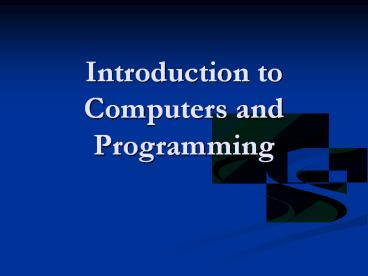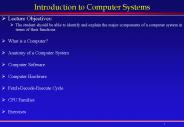Introduction to Computers and Programming - PowerPoint PPT Presentation
Title:
Introduction to Computers and Programming
Description:
Introduction to Computers and Programming Some definitions Algorithm: A procedure for solving a problem A sequence of discrete steps that defines such a procedure, or ... – PowerPoint PPT presentation
Number of Views:291
Avg rating:3.0/5.0
Title: Introduction to Computers and Programming
1
Introduction to Computers and Programming
2
Some definitions
- Algorithm
- A procedure for solving a problem
- A sequence of discrete steps that defines such a
procedure, or method - Computer Science
- Finding solutions to problems with the aid of
computers - The study of algorithms
3
Hardware
- Physical parts of a computer system
- Major components include
- CPU
- Memory
- Peripheral devices
4
CPU
- CPU consists of the control unit, the ALU, and
registers - registers high-speed memory cells
- ALU arithmetic logic unit performs calculations
- control unit copies data instructions from
memory, decodes instructions and follows them
5
Main memory
- Stores data instructions in bit form
- data information to be processed
- instructions commands for computer to follow
- bits binary digits two states represented as 1
or 0 - Memory is organized into 8-bit groups called
bytes - Each byte has its own unique address
6
Memory representation
- Each instruction or piece of data must be stored
in one or more bytes of memory - The arrangement of 1s and 0s in each 8-bit byte
can be interpreted as code representing a single
instruction or data item - Many data items and instructions require more
than one byte of memory well see why later
7
Memory size
- We typically discuss memory in increments of
millions (megabytes) or billions (gigabytes) - In fact, since the fundamental building-block of
memory is the byte, which is in turn based on the
bit, the actual size of what we call a megabyte
isnt really a million bytes, but the closest
power of 2 220, or 1,048,576 - Likewise, a gigabyte is actually 230 bytes, which
is 1,073,741,824
8
Software
- Consists of programs that can run on a computer
- Applications programs
- System programs
- A program is a set of instructions
- Data are the raw material letters and numbers,
for example
9
Character data representation
- Bit patterns are used to represent characters and
symbols - ASCII is a code system that matches 8-bit
patterns with natural language symbols, such as
letters, numbers, and punctuation marks a total
of 256 characters (28) can be represented - Unicode, a 16-bit system, is used in Java this
provides support for multiple languages and
alphabets
10
Integer data representation
- Integers, or whole numbers, are represented using
the binary, or base 2, numbering system - As in the more familiar base 10, or decimal
notation, a 0 digit represents a placeholder
other digits should be multiplied by the
corresponding power the base, starting with the
0th power for the rightmost digit, the 1st power
for the next one, the 2nd for the next, etc. - The sum of the digits multiplied by their
respective base powers is the value of the number
11
Decimal example
- The number 12,486 can be read (left to right) as
- (1 x 104) (2 x 103) (4 x 102) (8 x 101) (6
x 100) - 10000 2000 400 80
6 - For binary numbers, the principle works the same,
except that only 1s and 0s are used, and the
digit at each place is multiplied by 2 instead of
10 the sum is still the value (in base 10) of
the number
12
Binary example
- The number 110001102 can be read as
- (1 x 27) (1 x 26) 0 0 0 (1 x 22) (1 x
21) 0 - 128 64
4 2 19810 - Using binary representation requires several more
digits than does decimal - The largest number that can be represented in 8
bits is 111111112, or 25510 - If one bit is reserved for the sign (positive or
negative), than the magnitude of the number is
restricted to ? 27-1 (12710)
13
Integer representation
- The number of bits used determines the magnitude
of the numbers that can be stored - Signed numbers have more restricted magnitude
than unsigned numbers
14
Representing real numbers
- Like integers and characters, real numbers are
stored in binary form - Unlike integers, real numbers are represented
using scientific notation - in decimal, the number 12345 can be represented
as 1.2345 x 104, abbreviated 1.2345e4 - similarly, .00025 is represented as 2.5e-4
15
Representing real numbers
- In computers, binary notation is used
- Since binary numbers are composed of 0s and 1s,
any number can be represented with a whole part
of 1 so it isnt necessary to store a numbers
whole part, as it is always 1 - Therefore, several bits can be set aside to
represent the fractional part of the mantissa,
and several more bits can be used to represent
the exponent of the radix, 2
16
Representing real numbers
- Both the mantissa (its fractional part) and the
exponent are stored total number of bits is
apportioned between the two parts - Both components have a sign bit
- Number of bits used restricts both the magnitude
and the precision of the number to be
represented real numbers are always
approximations
17
Representation of Instructions
- Instruction set set of operations a particular
processor can perform - Specific to each hardware platform
- Encoded as binary digits
- Programming language language in which a program
is written consists of a set of symbols and the
rules for their use
18
Low-level languages
- Low-level languages operate at a low level of
abstraction that is, individual symbols have a
simple, well-defined, specific meaning - Low-level languages operate at or close to the
level of the computers instruction set that is,
the set of commands a processor is wired to
respond to
19
Low-level languages
- Specific and simple instructions, non-abstract
- Platform-specific and non-portable
- Difficult for humans to read and write
- Include machine and assembly languages
- Programs tend to be long, as each instruction is
extremely specific
20
High-level languages
- High-level languages exist at a higher level of
abstraction individual instructions are often
equivalent to several low-level instructions - High-level languages are closer to the natural
languages humans use to communicate
21
High-level languages
- High-level language programs require translation
to machine language before they can be executed
by a computer - As long as you have the software to do the
translation, you can run a high-level language
program on any kind of computer - thus,
high-level languages are said to portable and
platform non-specific
22
High-level languages
- Because the language is more abstract, a
high-level language program tends to be much
shorter than its low-level counterpart - Most well-known languages are high-level
languages - these include C, C, Java, FORTRAN,
BASIC, COBOL, Pascal, python, Ada, etc.
23
High-level languages
- Abstract
- Portable
- Relatively easy for humans to read and write
- Include most named languages
- Programs relatively brief
- Require translation to make executable
24
Programming Language Translation
- Interpreters perform line-by-line translation
and execution of a program - Compilers translate entire program into machine
language prior to execution - Java is unique uses both methods































